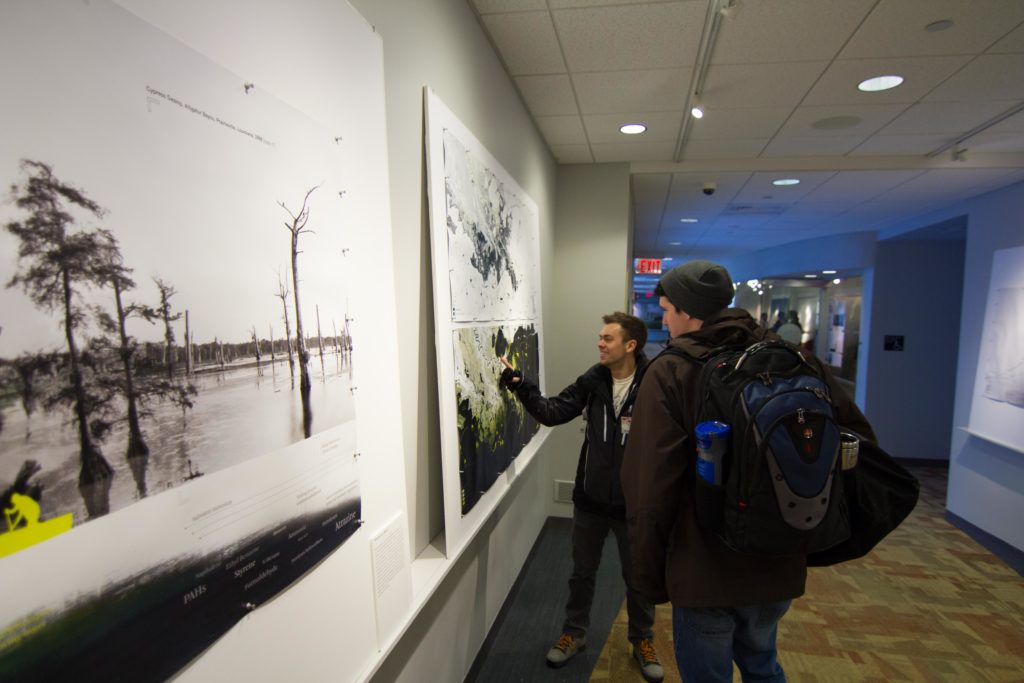By Jason Ritchey, new correspondent
In the 19th century, the land between Baton Rouge, La. and New Orleans was known as the River Road, a scenic segment of the Mississippi River featuring pristine nature speckled with grand plantation mansions. Today, it’s been dubbed “Cancer Alley” and is the subject of the exhibit Petrochemical America currently featured in Northeastern’s Gallery 360.
In the exhibit, photographer Richard Misrach’s haunting images of homes, cemeteries and farmland shadowed by refineries and processing plants are enhanced by landscape architect Kate Orff’s throughlines, or unique information visualization aids placed on the photographs.
“We are excited about this because there are hundreds upon hundreds of underwater pipelines running from all the offshore oil rigs as well as pipelines running through swamps and bayous on the land connecting to refineries and trains,” Phil Brown, director of the Social Science Environmental Health Research Institute at Northeastern, said. “Nobody’s ever put it all together in this way with such a comprehensive picture.”
Petrochemical America is based on a book by the same name published in 2012 by Aperture Magazine, which also organized the exhibit.
“The book is one of the best examples of using a place-based approach and an information system to overview all the different environmental hazards and social implications of the many factories, pipelines and refineries in the incredible stretch between Baton Rouge and New Orleans,” Brown said.
Brown along with Jane Amidon, director of Northeastern’s Urban Landscape Program, are responsible for the exhibit’s arrival at Northeastern.
“We were very intrigued by the book and wanted to bring one or both of the authors to campus, and the only way to do it was to have a mini-conference,” Brown said.
A half-day conference discussing environmental health and the intersection of art and data was scheduled for Jan. 26, a few weeks after the exhibit arrived on campus. However, a winter storm forced parts of the “Grounds for Engagement” event to be postponed.
“About half of the conference happened, due to the weather,” Bree Edwards, director of the College of Arts, Media and Design’s Center for the Arts, which manages Gallery 360 and organized the event, said.
Of the three scheduled speakers, the two who were able to attend highlighted the exhibit’s theme of making science and data accessible.
Sara Wylie, a professor of anthropology at Northeastern, discussed her book on the impact that fracking has on communities. Her collaboration with an artist and software developer created tools to help hold the industries accountable.
Laura Perovich, a doctoral candidate and research assistant at Massachusetts Institute of Technology (MIT), presented her work developing life-sized data displays of toxins present in humans.
“I’m a scientist by training, so I absolutely value an analytic approach,” Perovich said. “But I think at the end of the day, it has to be balanced by these artistic people to directly engage people by reframing the barrier to entry.”
Orff, the landscape architect featured in the exhibit is a professor at the Columbia University Graduate School of Architecture, Planning and Preservation in New York City, was unable to attend, but will come to campus for the postponed second half of the event on Feb. 26. Then she will lead a guided tour of the exhibit and join the Northeastern community at a reception.
On March 15, Northeastern is hosting the Toxic Action Conference – the largest environmental activist conference in New England – in conjunction with the end of the exhibit.
Petrochemical America comes to Northeastern after several years of touring. Most recently, it was at Pomona College in California.
“There, it sparked the discussion of the offshore drilling,” Edwards, who saw the exhibit at Pomona, said. “What I love about the conversation at Northeastern is that here it’s a conversation about design and technology, coastal sustainability and how artists can work with community groups to initiate change. Wherever it goes, it’ll be different and relating to the local community.”
Photo by Ethan Kaley









